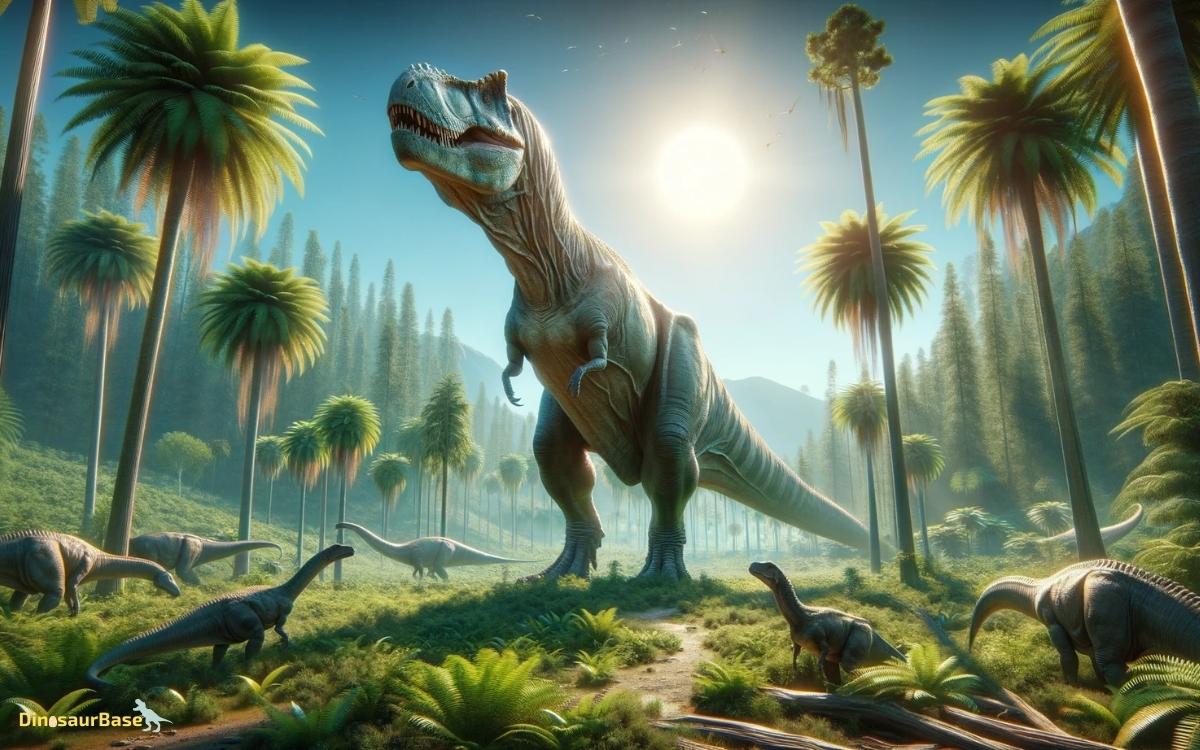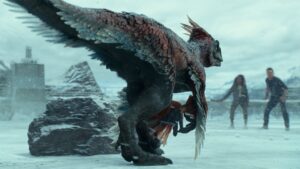What Dinosaur Was the Biggest? Sauropods!
In the realm of paleontology, the quest to identify the largest dinosaur has captivated scientists and enthusiasts alike.
Among the myriad of colossal creatures that once roamed our planet, the sauropods, with their elongated necks and massive bodies, consistently emerge as prime candidates.
Notably, the Argentinosaurus and Patagotitan stand out for their astonishing size, sparking debates over which truly merits the title of the largest dinosaur.
This discourse not only enriches our understanding of these magnificent beings but also underscores the complexities of paleontological measurement and interpretation.
Join us as we explore the evidence and theories that continue to shape our quest for the prehistoric titan.


Key Takeaway
The Quest for Size
In the scientific community, the quest for identifying the largest dinosaur species has led to rigorous paleontological studies, leveraging sophisticated methodologies to measure and compare fossilized remains with unparalleled precision.
This endeavor not only encompasses the physical dimensions of skeletal fragments but also delves into the complex interplay of biological and environmental factors that influenced dinosaur growth patterns.
Researchers meticulously analyze the morphology of dinosaur bones, employing advanced imaging techniques and biomechanical modeling to estimate the mass and size of these prehistoric giants.
Through such empirical investigations, scientists aim to construct a comprehensive understanding of dinosaurian gigantism, exploring its evolutionary implications and ecological significance.
This systematic approach underscores the commitment to empirical rigor and analytical depth that characterizes the scientific pursuit of knowledge regarding the history of life on Earth.
Understanding Dinosaur Measurements
Accurately measuring the colossal size of dinosaurs presents a complex challenge, necessitating the use of innovative techniques and technologies to estimate their dimensions from fossilized remains.
Researchers rely on comparative anatomy, scaling laws, and computer modeling to reconstruct these ancient behemoths.
The process involves intricate calculations and assumptions based on the available skeletal elements, often leading to revised estimations as new discoveries are made or methodologies improve.
| Methodology | Description |
|---|---|
| Comparative Anatomy | Involves comparing fossilized bones with those of modern-day relatives or well-understood species. |
| Scaling Laws | Utilizes mathematical relationships between an animal’s size and its biological functions. |
| Computer Modeling | Employs 3D models to simulate the structure and possible dimensions of dinosaurs. |
| Paleohistology | Examines bone microstructures to infer growth patterns and size. |
| Biomechanical Analysis | Analyzes the mechanical forces on skeletal structures to estimate muscle mass and body proportions. |
This scientific approach ensures a continually evolving understanding of dinosaur dimensions, providing insight into their lives and environments.
Sauropods: The Long-Necked Giants
Building on the methodologies for estimating dinosaur dimensions, the focus now shifts to Sauropods, the long-necked giants that once roamed the Earth.
These remarkable creatures are distinguished by several key characteristics:
- Extraordinary Size: Sauropods were among the largest animals to ever walk the Earth, with some species reaching lengths of over 100 feet.
- Long Necks and Tails: Their iconic long necks, which could comprise half their body length, allowed them to access vegetation unreachable to other herbivores.
- Quadrupedal Stance: Unlike many dinosaurs, sauropods were primarily quadrupedal, supporting their massive bodies on four sturdy legs.
- Diverse Lineages: This group includes a variety of species, each adapted to specific ecological niches, demonstrating the evolutionary success of the sauropod design.
Understanding sauropods offers insights into the ecological dynamics of ancient ecosystems and the limits of vertebrate size and structure.
Argentinosaurus: A Colossal Contender
In the realm of prehistoric giants, Argentinosaurus huinculensis stands as a formidable figure, marked by astounding size estimates that have intrigued paleontologists since its discovery.
The initial uncovering of its fossils in Argentina provided a pivotal moment in understanding the upper limits of dinosaur size, offering a substantial basis for comparison against other sauropod behemoths.
Detailed analysis and comparisons have since been pivotal in reconstructing its life history, physiology, and ecological impact, setting a benchmark for evaluating the magnitude of other colossal dinosaurs.
Argentinosaurus Size Estimate
Estimating the size of Argentinosaurus, a giant among dinosaurs, has presented significant challenges to paleontologists, given the incomplete nature of its fossil record.
- Incomplete Fossil Record: The scarcity and fragmentation of Argentinosaurus bones have led to a range of size estimates, making precise calculations difficult.
- Length Estimates: Reconstructions and comparative analysis suggest lengths of approximately 30 to 35 meters, positioning Argentinosaurus among the largest known dinosaurs.
- Weight Projections: Weight estimates have varied widely, with figures ranging from 70 to 100 tonnes, making it one of the heaviest terrestrial animals to have ever lived.
- Methodological Approaches: Diverse methodologies, including scaling from better-known sauropods and biomechanical modeling, have been employed to approximate its size, each with its own set of assumptions and potential errors.
Discovery and Fossils
The discovery of Argentinosaurus, marked by the unearthing of its first fossils in Argentina during the early 1990s, significantly expanded our understanding of the scale at which dinosaurs could grow.
Paleontologists unearthed vertebrae and limb bones that suggested an unprecedented size among known dinosaurs, prompting intensive study and speculation about the creature’s biology and lifestyle.
These fossils, primarily consisting of a series of vertebrae, ribs, and a portion of a femur, hinted at an organism of colossal proportions.
The detailed analysis of these remains allowed scientists to estimate the size and weight of Argentinosaurus, placing it among the largest terrestrial animals ever to exist.
The discovery underscored the importance of fossil evidence in reconstructing prehistoric life, offering a glimpse into the magnitude of dinosaur diversity and evolution.
Comparisons to Other Giants
When comparing Argentinosaurus to other prehistoric giants, it emerges as a formidable contender due to its estimated massive size and weight, reflecting significant evolutionary adaptations.
This titan of the Mesozoic era showcases unique attributes when juxtaposed with its colossal counterparts:
- Size and Scale: Argentinosaurus is believed to have reached lengths of up to 100 feet and weights exceeding 100 tons, rivaling or surpassing other sauropods.
- Bone Structure: Its vertebrae indicate a robust skeletal framework designed to support immense mass.
- Evolutionary Significance: Argentinosaurus exemplifies the peak of sauropod gigantism, providing insights into the ecological dynamics of its era.
- Comparative Analysis: When measured against contemporaries like Patagotitan, Argentinosaurus holds its ground in terms of size, suggesting a close competition among the largest dinosaurs ever to walk the Earth.
Patagotitan: The Heavyweight Champion?
Patagotitan, a titanic creature unearthed in the Patagonian region, has stirred the paleontological community with its monumental size and scale, challenging previous conceptions of dinosaur gigantism.
The discovery and subsequent excavation of this species provided a wealth of data, offering new insights into the physiology and environmental adaptations of these colossal beings.
Comparative analysis with contemporaneous giants such as Argentinosaurus has initiated a reevaluation of the hierarchy within the realm of the largest dinosaurs, placing Patagotitan in the spotlight as a potential heavyweight champion.
Size and Scale
Among the titans of the Cretaceous period, Patagotitan mayorum stands out due to its astonishing size and scale, potentially earning it the title of the largest dinosaur ever discovered.
This colossal sauropod’s dimensions are awe-inspiring, reflecting an organism that lived on a scale beyond the comprehension of most modern observers.
- Length: Estimates suggest Patagotitan could reach lengths of up to 37 meters (121 feet).
- Weight: Its mass is astonishing, possibly weighing as much as 69 metric tons (76 US tons).
- Vertebrae Size: Individual vertebrae were over a meter (3.3 feet) in width, supporting its massive structure.
- Comparative Scale: When compared to other giant sauropods, Patagotitan’s size places it among the upper echelons, challenging previous contenders for the title of the largest land animal known to science.
This scientific analysis underscores the impressive nature of Patagotitan mayorum, showcasing the remarkable scale of some of Earth’s ancient inhabitants.
Discovery and Excavation
Unearthed in the windswept expanses of Argentina’s Patagonia region, the first fossils of Patagotitan mayorum marked a groundbreaking discovery in paleontology, revealing the immense scale of this prehistoric giant.
Found in 2012, these remains sparked an extensive excavation process, meticulously uncovering over 150 bones from at least six individual dinosaurs.
This site, part of the Cerro Barcino Formation, provided invaluable insights into the titanosaur’s anatomy and size, offering a window into the lives of some of the largest creatures to have ever walked the Earth.
The meticulous recovery and preservation efforts underscored the significance of the find, shedding light on evolutionary patterns and the ecological dynamics of the Cretaceous period without directly comparing them to their contemporaries, focusing purely on the groundbreaking nature of their discovery.
Comparisons With Contemporaries
Having established the groundbreaking discovery of Patagotitan mayorum, it is now pertinent to evaluate how this titan measures up against its contemporaries in terms of size and ecological impact.
- Size Comparison: Patagotitan, with its estimated length of up to 37 meters and weight of about 69 tonnes, surpasses most known sauropods, including Argentinosaurus and Puertasaurus, which were previously considered among the largest dinosaurs.
- Ecological Dominance: This gigantic size implies a significant ecological footprint, likely dominating its habitat through sheer bulk and feeding capacity.
- Competition for Resources: Despite its size, competition with contemporaneous large herbivores would have necessitated efficient feeding strategies to sustain its massive body.
- Predation Pressure: Its sheer size might have offered a deterrent against predators, shaping the predator-prey dynamics of its ecosystem.
Other Gigantic Dinosaurs
While the title of the largest dinosaur might belong to a specific species, numerous other giants roamed the Earth during the Mesozoic era, showcasing remarkable diversity in size and form.
Among these, the Brachiosaurus, notable for its long neck and sizable body, is estimated to have weighed up to 62 tons and reached lengths of 85 feet.
Similarly, the Diplodocus, distinguished by its whip-like tail and elongated neck, spanned approximately 100 feet.
The Argentinosaurus, another colossal herbivore, is believed to have weighed up to 100 tons, with a length surpassing 100 feet.
These examples underscore the extensive range of gigantism in dinosaurs, reflecting diverse evolutionary pressures and ecological roles within their respective environments.
Beyond Size: The Importance of Dinosaurs
Exploring beyond their monumental size, the significance of dinosaurs extends to their pivotal roles in understanding Earth’s geological and evolutionary history.
Dinosaurs offer unique insights into:
- Biodiversity Over Time: By studying the variety and distribution of dinosaur species, scientists can infer patterns of biodiversity and ecosystem changes over millions of years.
- Evolutionary Adaptations: Dinosaurs exhibit a range of adaptations, providing a comprehensive view of evolutionary processes in response to Earth’s changing environments.
- Paleoclimatology: The presence and distribution of dinosaurs across various continents offer clues to past climates, continental drift, and the configuration of landmasses.
- Extinction Mechanisms: Understanding the causes behind the mass extinction of dinosaurs sheds light on current biodiversity crises and helps predict future ecological shifts.
FAQ About What Dinosaur Was the Biggest
How Did the Environment and Climate During the Mesozoic Era Contribute to the Enormous Sizes of Some Dinosaurs?
The Mesozoic era, a cradle of evolutionary innovation, fostered conditions conducive to gigantism in dinosaurs through abundant resources, favorable climate, and less gravitational constraints, enabling them to evolve into the colossal titans of ancient Earth’s ecosystems.
What Challenges Do Paleontologists Face When Estimating the Weight and Overall Size of Extinct Dinosaurs?
Paleontologists encounter numerous challenges in estimating the weight and size of extinct dinosaurs, including incomplete fossil records, the need for comparisons with modern animals, and interpreting soft tissue from bone structure.
How Does the Bone Structure of Gigantic Dinosaurs Compare to That of Modern Large Mammals, Like Elephants and Whales?
Gigantic dinosaurs, such as the Argentinosaurus, exhibited bone structures vastly denser than those of modern large mammals, including elephants and whales, facilitating support for their immense mass and promoting evolutionary adaptations to their colossal size.
Were There Any Significant Predators of These Giant Dinosaurs, and if So, How Did They Hunt Such Large Prey?
Significant predators of the largest dinosaurs included large theropods, which likely employed strategies such as ambush, targeting young or weak individuals, and possibly hunting in packs to overcome the size advantage of their massive herbivorous prey.
How Do Scientists Use Technology, Such as Computer Modeling and 3D Scanning, to Reconstruct the Appearance and Movements of These Massive Dinosaurs?
Scientists employ advanced technologies such as computer modeling and 3D scanning to meticulously reconstruct the appearance and movements of massive dinosaurs, offering a window into the ancient past through digital resurrection and animated simulations.
Conclusion
The quest to identify the largest dinosaur continues to captivate scientists and enthusiasts alike. Among the contenders, Patagotitan currently stands out as the heavyweight champion, with estimates suggesting it could weigh as much as 69 tons.
This pursuit not only expands our understanding of dinosaur gigantism but also sheds light on the ecological dynamics of prehistoric ecosystems.
The significance of these discoveries extends beyond mere size, highlighting the incredible diversity and adaptability of dinosaur species throughout the Mesozoic era.



